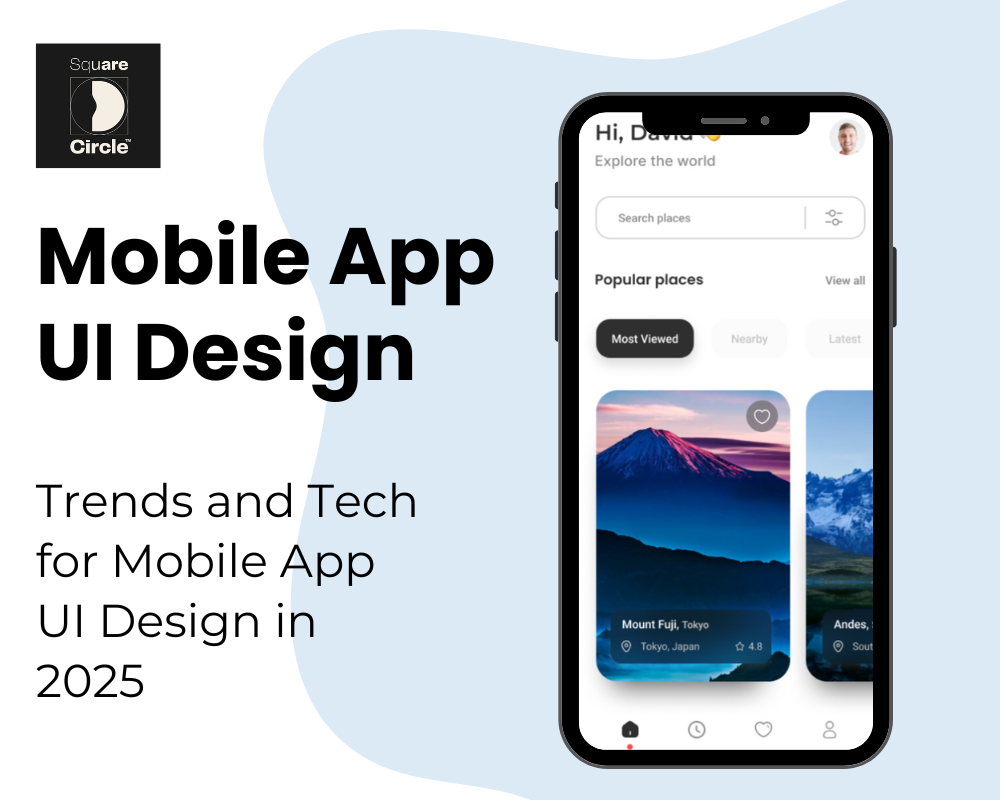
How to Create Mobile App UI Design? | Complete Guide 2025
Oct 25, 2024
Mobile app UI design has become essential in shaping user experiences for mobile applications. Whether you're a seasoned designer or a beginner, crafting an intuitive, attractive, and responsive mobile app interface requires skill, knowledge, and creativity.
This guide will walk you through the entire process of creating mobile app UI designs in 2024. Additionally, we will touch upon the expertise of SquareDC UI UX Design Agency, one of the best UI/UX design agencies, to illustrate industry-leading design practices.
How to Create Mobile App UI Design?
Creating the perfect Mobile App UI Design isn't just about making a pretty interface—it’s about delivering a seamless experience for users that’s functional, engaging, and accessible. In today's competitive app market, a well-designed UI can make the difference between an app that users love and one they abandon after a single use.
The user interface (UI) focuses on the look and style of your app, while the user experience (UX) ensures that the app feels intuitive and easy to use. Combining both to create a successful mobile app design requires strategic planning, creativity, and an understanding of the latest trends in 2024.
Understanding the Fundamentals of UI/UX Design
Before we dive into the technical details, let’s understand the difference between UI UX Design. UI stands for User Interface, which refers to the visual elements, like buttons, icons, and layouts, that users interact with. On the other hand, UX (User Experience) encompasses the overall feel of the experience a user has while navigating through the app.
The goal of UI/UX design is to make the app not only aesthetically pleasing but also highly functional. A beautiful UI will fall flat without an intuitive UX.
Key Principles of Mobile App UI Design
When working on Mobile App UI Design, several core principles ensure that your design is user-friendly and visually appealing. Here are key principles to consider:
1. Simplicity and Clarity: A clean and minimalist design is essential in Application UI Design. Users should be able to navigate the app without feeling overwhelmed. This involves removing unnecessary elements and focusing on essential features that serve a clear purpose.
2. Consistency: Consistency in visual elements such as colours, fonts, and button styles builds trust and familiarity. Users should find the same design elements across various screens, making navigation intuitive and reducing cognitive load. Establishing a mobile app UI design system or style guide can help maintain this consistency throughout the mobile app.
3. Intuitive Navigation: Clear navigation is critical for a seamless user experience. Implement recognizable icons and labels, and consider using bottom navigation bars for easy access to primary features. Gestures like swiping can enhance interactions, but they should be intuitive and well-indicated.
4. Visual Hierarchy: The arrangement of elements on the screen should guide users' attention effectively. Use size, color, and typography strategically to create a clear visual order that highlights important information while grouping related elements together.
5. Responsive Design: Your app must adapt to various devices and orientations, ensuring that it looks good and functions well on all screen sizes. This includes designing for both portrait and landscape modes.
6. Accessibility: Designing with accessibility in mind ensures that all users, including those with disabilities, can effectively use your app. This involves using sufficient colour contrast, allowing font size adjustments, and incorporating voice interaction capabilities which will lead to better mobile app UI design.
7. Feedback Mechanisms: Providing users with feedback on their actions enhances the overall experience. This can include visual cues or loading indicators that inform users about the status of their actions.
8. User-Centric Design: Understanding user behaviour is crucial in UI UX App Design. Conducting user research helps identify needs and preferences, allowing designers to create interfaces that resonate with users.
9. Prioritise Readability: Text should be easy to read, with appropriate line spacing and character limits per line (ideally no more than 40 characters). This enhances comprehension and ensures that users can easily consume content within the app.
10. Streamlined Onboarding: A smooth onboarding process helps users understand how to navigate the app quickly. This can involve tutorials or guided tours that highlight key features without overwhelming new users.
By adhering to these principles in your Mobile App Interface Design, you can create an engaging, effective, and user-friendly application that meets the needs of your audience while maintaining aesthetic appeal.
Also Read: Generative AI and Its Impact in the UI UX Industry
Mobile UI UX Insights 2025
User-Centric
52% of users uninstall apps with poor design or UX.
88% are less likely to return to an app after a bad experience.
Responsive Design
61% of users have a higher opinion of a brand if its app is optimised for multiple screen sizes.
Gestures
Apps that rely on gestures (e.g., swipe, tap) see 25% higher engagement rates compared to apps with only buttons.
Performance
53% of users abandon apps that take more than 3 seconds to load.
A 1-second delay in load time can reduce conversion by 7%.
Dark Mode
Dark mode reduces battery usage by up to 63% on OLED displays.
82% of users enable dark mode on their devices when available.
Minimalist Design
Minimalist designs can increase user engagement by 35%.
Reducing visual clutter improves task completion rates by 20%.
AI/ML Personalization
Personalized UX through AI increases retention rates by 15%.
70% of users expect apps to provide personalised content.
Accessibility
Apps that follow accessibility guidelines reach 15% more users, including those with disabilities.
71% of users with disabilities will leave an app if it's not accessible.
Micro-interactions
Apps with engaging micro-interactions show a 20% increase in daily active users.
Subtle animations and feedback can improve task success rates by 12%.
VUI (Voice User Interface)
Voice search and navigation usage is expected to grow by 30% annually.
41% of adults use voice search at least once a day, driving demand for VUI integration.
Mobile App Design Techniques in 2025
As mobile app design continues to evolve, several key techniques and trends are shaping the landscape in 2024. This year emphasises user-centric approaches, innovative technologies, and aesthetic simplicity, creating a rich environment for Mobile App UI Design, Application UI Design, and Mobile App Interface Design.
Key Techniques and Trends in Mobile App UI Design
User Experience (UX) Focus
User Research and Personas: Understanding user behaviour through research is essential for creating tailored experiences. Developing detailed personas helps designers address specific needs and preferences effectively, which helps in increasing mobile app UI design status.
Intuitive Navigation: A logical navigation structure enhances usability, making it easier for users to find what they need without confusion.
Responsive and Adaptive Design
Responsive Techniques: Implementing flexible grids and media queries ensures apps adapt seamlessly to various screen sizes and orientations, crucial for diverse device usage.
Adaptive Contextual Design: This approach considers the user's context (location, device capabilities) to tailor experiences dynamically, enhancing relevance and engagement.
Minimalistic Aesthetics
Simplicity in Design: Minimalism remains a dominant trend, focusing on essential functionalities while eliminating clutter. This aligns with modern user preferences for clean and efficient interfaces, leads to better mobile app UI Design.
Bold Typography: Using striking typography can enhance visual impact and brand personality, making important information stand out.
Innovative Interaction Methods
Gesture-Based Interactions: Incorporating gestures like swiping and pinching makes interactions feel more natural and intuitive, improving overall user satisfaction.
Voice User Interfaces (VUIs): With the rise of voice technology, designing effective VUIs allows for hands-free interactions, catering to accessibility needs.
Advanced Visual Techniques
3D Graphics and Animation: The use of complex 3D visuals is gaining traction, providing depth and interactivity that enhance user engagement. However, it’s crucial to ensure these elements support rather than detract from usability.
Creative Motion Design: Integrating animations throughout the app not only enhances usability but also adds aesthetic appeal, making interactions more engaging.
Augmented Reality (AR) Integration
AR continues to expand beyond gaming into practical applications like virtual try-ons or interactive tutorials, enriching the user experience by blending digital content with the real world.
Performance Optimization
Mobile-First Strategies: Prioritising mobile app UI design from the outset ensures optimal performance on mobile devices, leading to faster load times and improved user experiences.
Battery and Network Efficiency: Optimising apps for low battery consumption and variable network conditions is vital for maintaining user satisfaction in diverse environments.
Personalization through Predictive Analytics
Leveraging AI and machine learning for predictive analytics allows apps to offer personalised content recommendations based on user behaviour, enhancing engagement by making experiences more relevant.
Colour Theory and Typography in Mobile App UI Design
Colour theory and typography are fundamental elements in Mobile App UI Design, significantly influencing user experience and engagement. Effective application of these principles can enhance usability, establish brand identity, and guide user behaviour within the app.
Colour Psychology: Different colours evoke specific emotions and reactions. For instance:
Blue: Trust and dependability, often used in banking apps.
Red: Urgency or excitement, commonly seen in sales or gaming apps.
Green: Calmness and health, suitable for wellness or finance apps.
Colour Harmony: Utilising complementary or analogous colour schemes can create visual balance. A well-chosen palette not only enhances aesthetics but also improves readability and navigation. For example, using a light background with dark text increases contrast, making content easier to read on smaller screens.
Accessibility Considerations: Ensuring colour choices accommodate users with visual impairments is crucial. Tools like contrast checkers can help designers meet accessibility standards, ensuring that text is legible against its background.
Typography in Application UI Design
Font Selection: Choosing the right typeface is essential for clarity and brand representation. Sans-serif fonts are often preferred for mobile apps due to their clean lines and readability at various sizes. For instance:
Roboto: Widely used in Android applications for its versatility.
Helvetica Neue: Popular in iOS apps for its modern aesthetic.
Hierarchy and Readability: Establishing a clear typographic hierarchy helps users navigate content efficiently. This can be achieved by varying font sizes, weights, and styles:
Headings should be bold and larger to draw attention.
Body text should be smaller but legible, maintaining consistent line spacing for better readability.
Line Length and Spacing: Optimal line length (around 50-75 characters) and appropriate line height (1.5 times the font size) enhance reading comfort on mobile screens. These factors contribute to a smoother reading experience, crucial for retaining user engagement.
Integrating Color Theory and Typography
In UI UX App Design, the integration of colour theory and typography can create a cohesive visual language. Here are some strategies:
Consistent Branding: Use brand colours consistently across typography to reinforce brand identity.
Visual Hierarchy: Employ colour contrasts to differentiate between headings, subheadings, and body text, guiding users through the app’s content seamlessly.
- Contact Us
Scroll
Related Blogs
Contact Us
- India
- United States
- Netherlands
- Australia
- Dubai
- Vietnam
interested?




